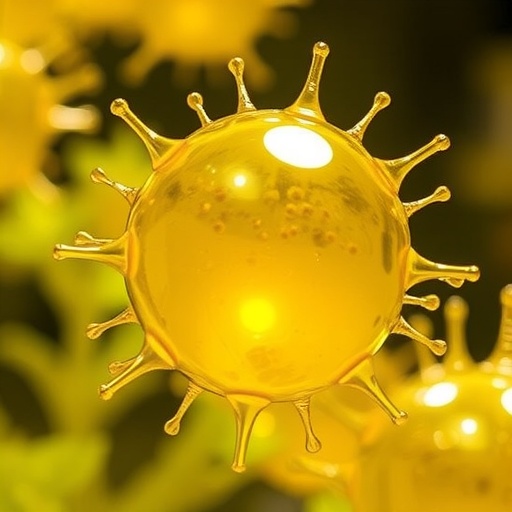Cyanobacteria, also referred to as blue-green algae, exhibit remarkable adaptability across diverse aquatic environments, from extreme hot springs to icy Arctic regions. Their resilience is significantly attributed to a unique molecular structure known as the phycobilisome. This extraordinary light-harvesting apparatus serves a dual purpose: harnessing energy from sunlight while simultaneously providing a protective mechanism akin to sunscreen against harmful light levels. This dual functionality highlights the evolutionary sophistication underlying these microorganisms, which have persisted across eons.
Central to the photoprotection capability of cyanobacteria is a specific accessory protein, known as the orange carotenoid protein (OCP). This protein plays a crucial role in regulating light absorption, effectively sensing excess light and acting to shield the organism from potential damage. Researchers have recognized the significance of this protein, yet its precise mechanisms of action remained elusive until recently.
The quest to unveil these mechanisms led a team of researchers from the University of Chicago Pritzker School of Molecular Engineering to focus on the interaction between OCP and the phycobilisome complex. Their findings promise to stimulate innovative biomimetic approaches in plant engineering for enhanced food security and to inform the development of adaptable energy technologies that draw inspiration from nature’s solutions.
Recent collaborative efforts with the Kerfeld Lab at Michigan State University resulted in the revelation of a surprisingly distinct molecular structure regarding how OCP binds to phycobilisomes. This revelation piqued the interest of Assistant Professor Allison Squires from UChicago PME. She noted the complexity of binding interactions due to the various architectures of phycobilisomes, questioning the impacts of these diverse structures on OCP functionality.
Employing a combination of high-precision spectroscopy and computational modeling, Squires and her research team discovered that OCP binds to specific sites located within distinct phycobilisome architectures and retains consistent functionality across these different binding scenarios. This adaptability suggests that OCP has evolved to efficiently fulfill its protective role despite variations in its structural context.
Squires articulated this phenomenon as a clear representation of a molecular mechanism’s adaptability. The evolution of OCP may have allowed it to inhabit various binding sites as phycobilisome architecture evolved, thereby ensuring the resilience of light-harvesting and photoprotection processes against changing environmental conditions. Such flexibility could herald advancements in synthetic biology, where mimicking these methods may allow researchers to engineer plants or energy systems that can adjust dynamically to fluctuating light levels.
To probe deeper into the binding dynamics, the research employed state-of-the-art single-particle spectroscopy techniques, specifically utilizing an Anti-Brownian Electrokinetic (ABEL) trap. This technology provided the researchers with the ability to analyze energy transfer at the nanoscale while immobilizing their protein samples within a liquid environment. The precision of the setup facilitated the detailed observation of how OCP binds to two notable types of phycobilisomes—one structured with three barrels and another with five—demonstrating the protein’s consistent quenching effect regardless of binding location.
Furthermore, computer simulations modeled the behavior of photons interacting with the bacteria, offering insights into the energy absorption pathways and how OCP mitigates excess energy that can be detrimental to cyanobacteria. The results reveal that nature strikes an elaborate balance between modularity—where structures can adapt to a variety of scenarios—and specificity—where proteins exhibit selective binding characteristics.
Looking ahead, the research team aims to investigate further facets of phycobilisome systems to decipher the regulatory mechanisms that govern energy capture. Not only does OCP serve a protective role, but preliminary observations suggest that phycobilisomes may house intrinsic ‘switches’ that smartly control energy flow under varying light conditions, breaking apart at defined moments and locations to modulate this transfer.
Ejaz, the first author of the study, expressed excitement at how the precise data garnered from the ABEL trap could yield profound structural insights on the quenching mechanisms enacted by OCP. As the team progresses, they are eager to uncover what additional patterns might emerge from integrating their findings with future comparative studies of photoprotective strategies.
These forthcoming endeavors could pave the way for breakthroughs in our understanding of energy management in photosynthetic organisms, ultimately leading to practical applications in agriculture and renewable energy technologies that utilize the adaptive mechanisms found within natural systems.
Understanding how OCP interacts with phycobilisome structures positions scientists closer to harnessing similar principles in engineered systems. By unraveling these molecular intricacies, researchers strive not only to uplift food production methods but to innovate sustainable energy pathways inspired by nature’s time-tested solutions. The full ramifications of this research may even prompt a whole new era of biodesign, where biological systems influence energy management and plant resilience.
The paper detailing these findings, titled “Phycobilisome core architecture influences photoprotective quenching by the Orange Carotenoid Protein,” has been published in the esteemed journal “Proceedings of the National Academy of Sciences.” Such contributions underscore the critical interplay between research and real-world applicability, illuminating the necessity of advancing our ecological understanding to meet future global challenges.
As the team continues its exploration, the hope remains that their work will foster collaborative efforts across disciplines, joining the fields of molecular engineering, environmental science, and sustainable agriculture in an endeavor aimed at influencing the future of our planet’s resource management.
Subject of Research: Interaction of Orange Carotenoid Protein with Phycobilisome Structures
Article Title: Phycobilisome core architecture influences photoprotective quenching by the Orange Carotenoid Protein
News Publication Date: 7-Oct-2025
Web References: Proceedings of the National Academy of Sciences
References: DOI: 10.1073/pnas.2420355122
Image Credits: UChicago Pritzker School of Molecular Engineering / John Zich
Keywords
Cyanobacteria, phycobilisomes, orange carotenoid protein, photoprotection, photosynthesis, molecular engineering, energy transfer, adaptive mechanisms, biomimetic strategies, single-particle spectroscopy.
Tags: aquatic environment adaptabilitybiomimetic approaches in engineeringcyanobacteria climate adaptationcyanobacteria research advancementsevolutionary biology of microorganismsextreme environment resiliencefood security innovationslight-harvesting mechanisms in algaeorange carotenoid protein functionphotoprotection in cyanobacteriaphycobilisome molecular structuresustainable energy technologies inspired by nature





